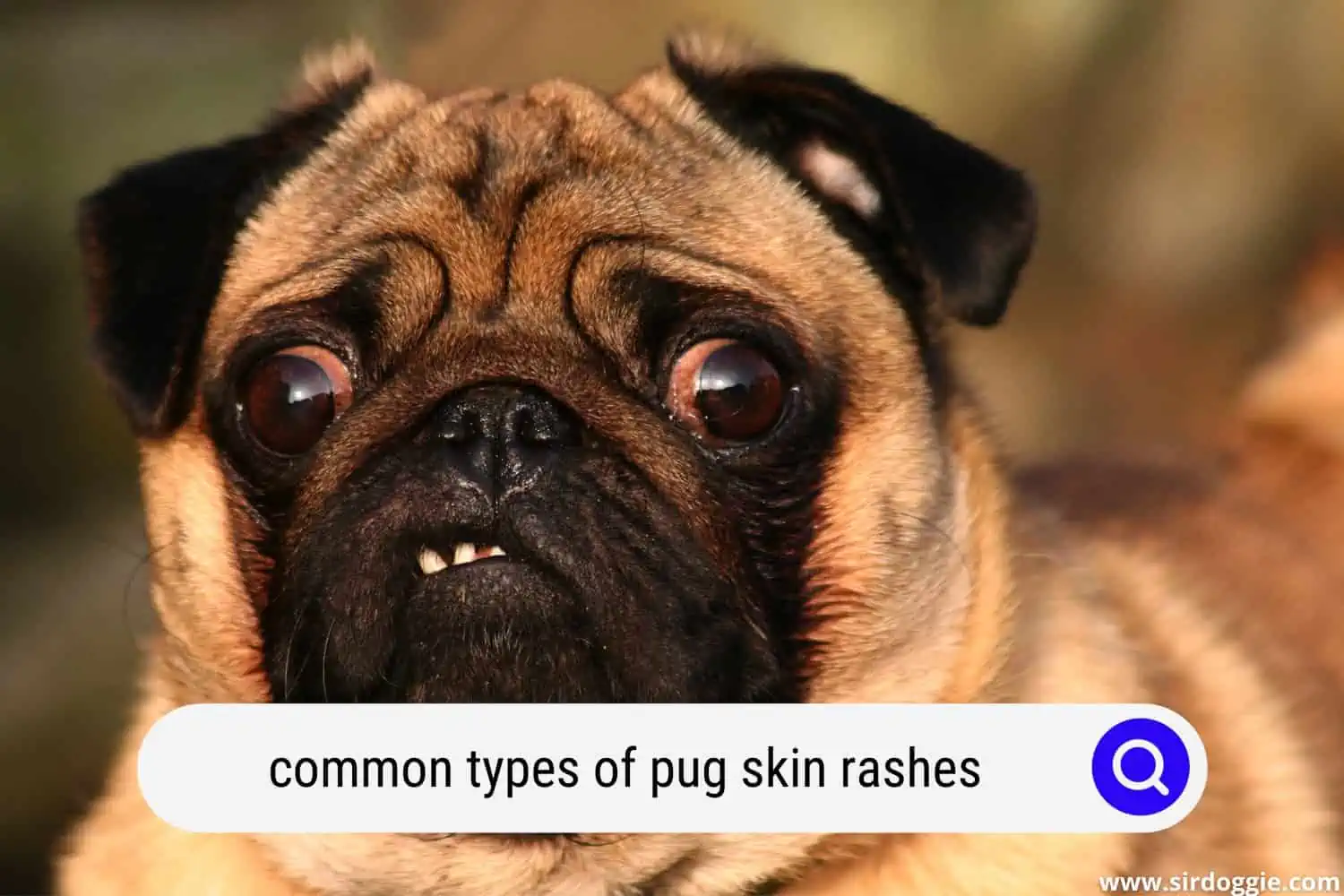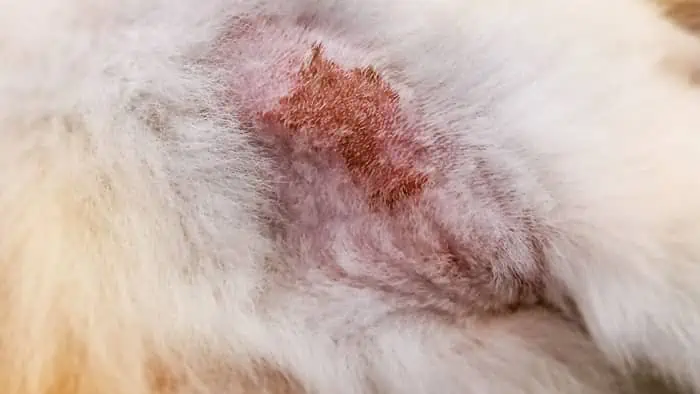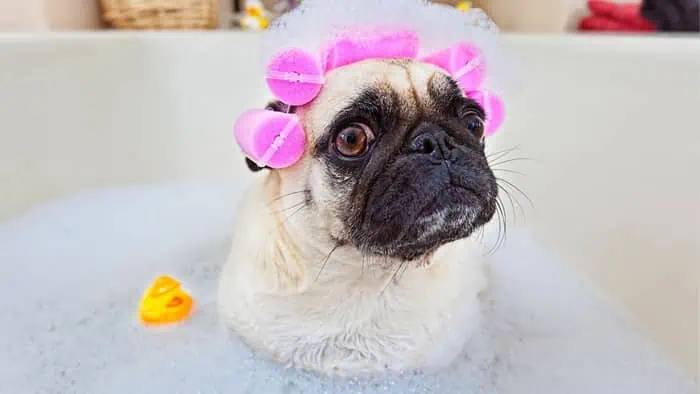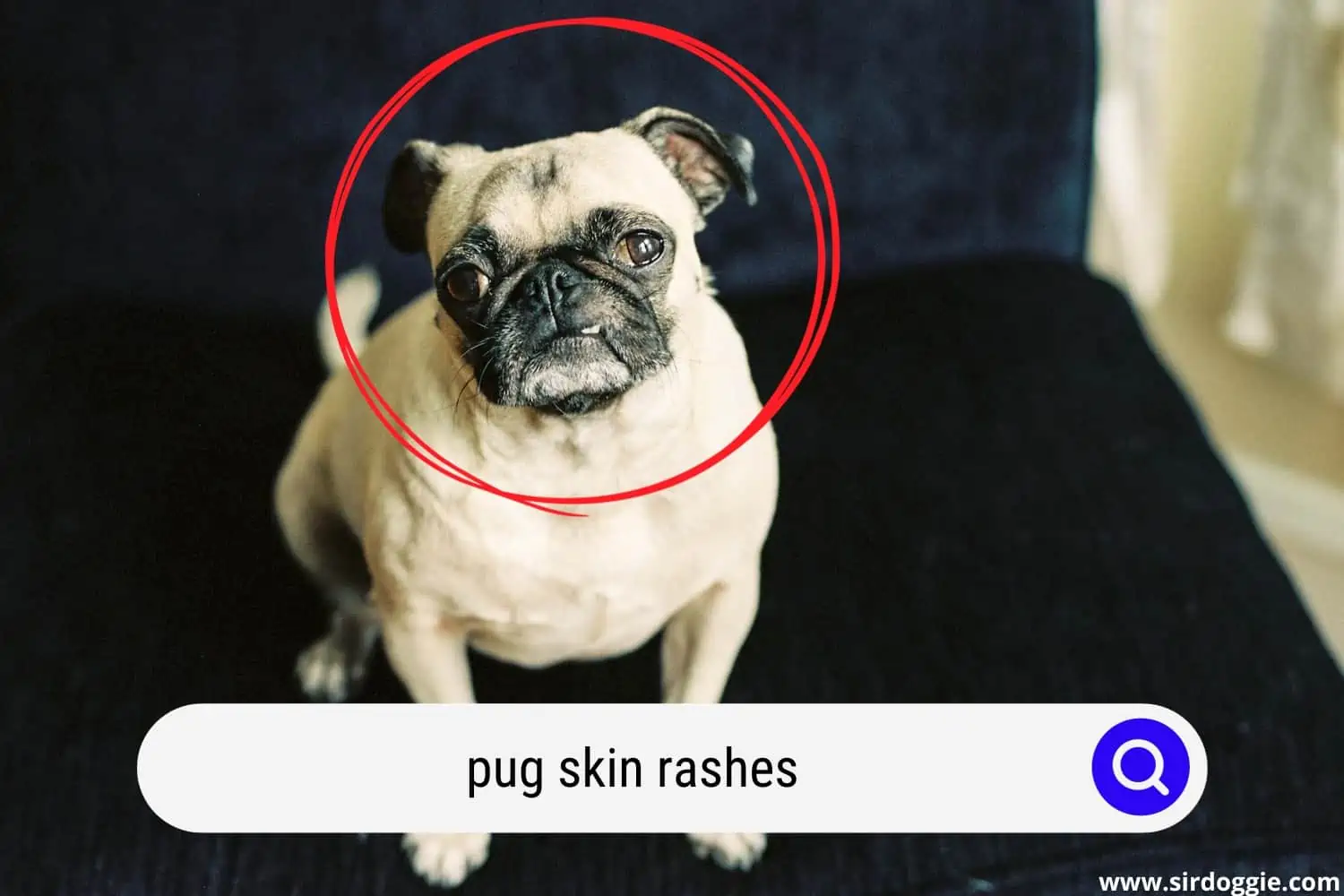Pug Skin Rashes: Common Types and What To Do About Them
Every Pug owner knows that his/her fur baby has a very unique appearance which distinguishes it from other canine species. That adorable flat face, irresistible big peepers, curled in a pretzel-shaped tail, and cute triangle ears. However, what also distinguishes Pugs from other species are the numerous health problems they tend to inevitably inherit. One of them is various skin conditions, developing as a reaction to outside factors like pollen, dust, and dirt. Also, they can develop allergic reactions to some types of food. Let’s talk about the main Pug’s skin rashes as well as the reasons that are at the root of wrinkle-faced derma misery.

Why Do Pugs Have Bad Skin?
One of the main causes of Pug’s dermatitis and other types of Pug’s skin infections is hidden in their “visage” structure. Since they have so many cute wrinkles covering their face as well as the whole body on some occasions, those same folds are causing disturbing Pug’s skin conditions. If they are not cleaned properly promptly, bacteria will harbor right in between creases leading to major irritation. Not all dog owners are responsible enough to keep up with proper pup hygiene. More so when it comes to very specific wrinkle-faced breeds.
It is not hard to keep your Pug clean as well as bacteria-free. All you have to do is just take a damp, clean cloth and wipe all the wrinkles real well, going deep into the creases. After that, take a dry clean cloth and wipe those down well again, making sure that no moisture is left behind. Soon you will notice how your pal’s derma starts to look a lot better and Pug’s skin rashes will become history.
And now let’s talk about the most common pug skin problems that you can observe and the symptoms accompanying them.
A-List Of Most Common Pug’s Skin Rashes
Dermatitis

An irritation occurs usually as a response to pollen, dust mites, or parasites like ticks and fleas. A pet owner can see his/her pet’s skin becoming flaky, red, and swollen in some spots. Your pal will constantly be scratching itself, aggravating its dermatitis even more. Pay a visit to a vet for advice on a specific treatment plan.
Food Allergies
More common than not, most canines are prone to developing those, no matter what the breed is. Nuts, fruit, dairy, and certain processed foods are topping the allergy-causing charts. It is very important to introduce those above-mentioned products slowly, one little bite at a time. And note if any adverse reactions follow.
Psoriasis
Unfortunately, canines can develop psoriasis just like humans do. You can spot patches of severely dry, irritated derma, which flakes easily upon touching. Reasons usually are hidden in the weakened immune system, where healthy cells are being destroyed and substituted by abnormal ones. The latter start reproducing at high speeds and start piling on top of each other. That is exactly what’s causing flaking. To nib, this problem in the bud, a vet of your choice should prescribe an ointment or a medicated cream to help get your Pug back to normal.
Demodectic Mange
It is one of the Pug’s skin rashes that is caused by the parasite called Demodectic mite. Wrinklefaces that have weak immunity are especially susceptible to that. Usually, the mange attacks baby Pugs, however, older Pugs may get it as well if their system is compromised. A very distinctive sign that your pal has managed is when you see patches of hair falling out uncontrollably, creating bold spots that are very red and itchy. It is usually treated with medicated topical creams.
Skin Scabs
May go hand-in-hand with the above-described mange condition. They form when a pup starts excessively licking on its irritated and, in some instances, broken skin, introducing bacteria and fungi right into the wound. Short-maned canines are susceptible to them more than long-haired ones. To prevent further damage, it might be necessary for a pooch to wear a recovery medicated collar. It will stop further excessive licking attempts.
Mites
Affect dogs whose skin forms distinctive folds, especially ears. Pugs’ ears fold over easily, therefore, they become the perfect “mite candidates.” Dirt and grime get trapped right in the creases and since the ear canal is always moist, the combination of these becomes a “ticking bomb.” Extremely social pooches are at high risk of getting mites since they can get if from their canine play buddies in dog parks or daycares.
Ringworms
A common fungal infection, affecting Pug’s derma and causing major irritation, creating patches of dry, scabby skin. If you have a cat bud living with you, it is very possible that your mutt got it from its feline sibling. Or, another option might be contaminated soil. It is enough for a pooch to roll around in it and get fungi all over its body.
Now, all of those Pug’s skin rashes sound very unpleasant. How do you as a dog owner nib them in the bud, so your bud doesn’t suffer?
Related Reading: How To Spot and Treat Hot Spot On Pug?
How To Prevent Pug’s Skin Infections?
1. Pup’s Hygiene
Make sure you clean your precious Pug real well, paying particular attention to his folds that are more susceptible to harboring microbes. Pugs don’t need to be bathed often. Yet, if you notice a foul smell coming from your wrinkled fella, it is time for a clean-up.

2. Proper House Cleaning Techniques
Since all Pugs are prone to various skin conditions, it is imperative to dust, mop floors, and vacuum your place often. This way you guarantee that your precious little pal will forget about its dust allergies and will become a happier camper than it already is.
3. Good Nutrition
A great diet is one step closer to a healthier pooch, who can be proudly parading its gorgeous mane, free of parasites, and infections. You have probably heard the expression: “You are what you eat.” It is true not only about humans but about canines as well. The right type of nutrition can aid in developing a stronger immunity, therefore shielding a Pug pal from various skin issues.
4. Prevent Canine Allergies
Introduce any new foods to a hound slowly, one bite at a time to see if he/she might get an adverse reaction. As a pet parent, you just never know what your furry friend might be allergic to. Some allergens can surprise you, as you would never think that regular healthy snacks like certain fruits, veggies, grains, and nuts may hurt your pup rather than help it.
5. Regular Vet Visits
A no-brainer. You just have to be on top of your bud’s health at all times. After all, it depends on you for everything, including your well-being. So, please, be a responsible owner and pay regular visits to your local veterinary doctor. A yearly check-up is a must for any fluffy fella, and those are even more important when a Pug friend reaches its “golden age.”

Curl-Up
Pug’s skin rashes are very common among wrinkled companions, as we just learned. As soon as you notice any type of scabs, major irritation, flakes, or itchiness, contact your trusted vet without delay. Sometimes a minor and a major skin infection might have similar symptoms. Hence, a professional will be able to dig deep into the matter to learn what the root of the problem is.

Family Dog Expert Author
Hi there! I’m Stuart, a devoted dog lover and family dog expert with over a decade of experience working with our furry companions. My passion for dogs drives me to share my knowledge and expertise, helping families build strong, loving bonds with their four-legged friends. When I’m not writing for SirDoggie, you’ll find me hiking, playing with my beautiful dog, or studying music.